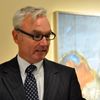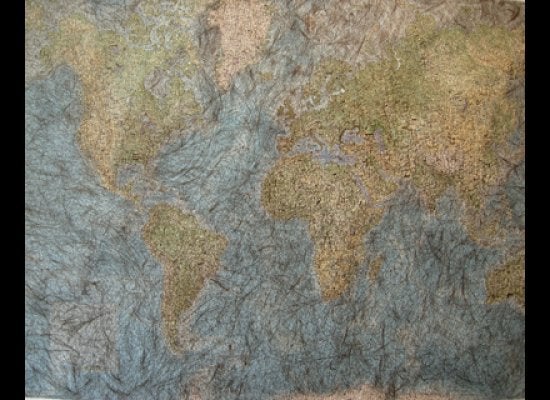This represents part of an online exhibition at the Torrance Art Museum, June 7 - July 26.
"At our best, we don't make road maps so much as chart the territory (...) Each of us stands at one unique spot in the universe, at one moment in the expanse of time, holding a blank sheet of paper. This is where we begin." Peter Turchi, "Maps of the Imagination: The Writer as Cartographer"
Cartographia: Artifacts of a Creative Journey
This exhibition proposes that artists are mapmakers, their works, maps, and their audience, orienteers. It also suggests a correlation between its content and form. If maps and mapping strategies are the content, then a virtual exhibition is its form. What is web surfing and its clickstream but synonyms for the mapping of a journey through the digital landscape?
Orienteering comes from the Swedish word orientering. It has its roots in late 19th century military training. Since then, it has since become a popular, competitive sport. It consists of a cross-country race with nothing more than a map and a compass. Minus the competitive aspect, orienteering provides an apt metaphor for this exhibition. We can define it as the reading of works of art. Readers of art use moral compasses to explore the artist's mapped experience and imagination.
In a general sense, it's also a sensible way to think about art. Each artist in the exhibition explores and then maps the as-yet unknown territory of her or his respective life. Some of the artists incorporate fragments of actual maps into their work. Some create imaginary, idiosyncratic maps. And some use mapping strategies (for instance, images made from library catalogue cards). Peter Turchi calls mapmaking a two-step process of exploration and presentation. (His topic is writing, but his ideas translate well to art.)
Artists begin at a coordinate-less Ground Zero. Their work process is the odyssey. Their work reveals depths plumbed, insights gained, and grace conferred. Presentation refers to the visual articulation and dissemination of this humanity. More often than not, the work conflates the two processes. Marks on the pictorial surface leave traces of both the journey and its destination. Orienteering, then, shows how the viewer follows the existential breadcrumbs left by the artists.
Like maps, art can be political, social, economic, and philosophical. The work in this exhibition is no exception. Despite their different references, themes, and styles, each work serves to seek, to find, and then to guide. It provides a path as well as a destination. Step by step, it shows the decisions that went into its creation. Critical cartographer Denis Wood notes that mapmakers base their work on conventions and assumptions. So do these artists. In a letter that Thomas Wolfe wrote to F. Scott Fitzgerald, he compared the amount of detail the two writers put in their stories. Fitzgerald, he said, was a "leaver-outter" while he was a "putter-inner." What artists omit is often as significant as what they include.
For every benefit of a virtual exhibition, there's a drawback. Administrative labor and costs may decrease. At the same time, though, the joy and serendipity of studio visits and shoptalk recede from view. Countless works of art may be available for such an enterprise. And yet, the thrill of seeing studio work hung on a museum wall disappears.
One thing that doesn't change is scale. In the old days, slide lectures would standardize the size of images on the screen. An enormous Raphael painting and a small Da Vinci drawing would, when projected on the wall, appear to be the same size. Substitute jpegs for slides and, as with maps, you've got the same distortion.
You might think that the exhibition's online installation would be bereft of visual dynamics. Not only does homogenization mess up the works' proportions. Scrolling down a web page prevents anything but lateral relationships. And, because the space is a virtual one, the work can't respond to the architecture that created the gallery space. The Curator can't move viewers through the exhibition by the placement of works. He can neither acknowledge stylistic similarities nor explore thematic atmospheres. Imagine being at a dinner party where you can only talk to your neighbor and not to someone across from you or otherwise down the table. In other words, all the fun of installing an installation is gone. To read the show is like reading text on a papyrus scroll that unfurls up- or downward into an imagined infinity.
It is possible, though, to include more artists and more works than a Gettyesque budget would allow. A virtual show allows the use of hyperlinks for reference. It encourages social media for dialogue. And it takes advantage of email to broadcast the show all over the globe.
This exhibition itself is a map. It results from a journey. Its destination is a beginning. Perhaps it will inspire people to explore otherwise unknown artists and works of art. Perhaps they will do so with the metaphors of mapmaker, map, and orienteer. In so doing, they might discover, as shown here, that art may be infinite but that it's also universal. Finally, they might see how, minus its rants and cants, art can affect their lives. Arrival at any one of these sites would affirm that this exhibition reached its own particular destination.

